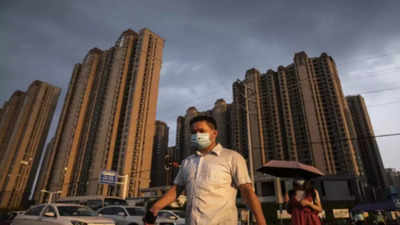China’s Q1 GDP beats forecast, but March activity heightens risks to outlook – Times of India

BEIJING: China’s economic activity slowed in March, with weakness in consumption, property and exports eclipsing faster-than-expected first quarter GDP growth, suggesting a worsening in the outlook as sweeping Covid-19 curbs and the Ukraine war take a toll.
The Ukraine crisis has complicated the job of policymakers as it has intensified supply and commodity cost pressures, boosting global inflation sharply and leaving Chinese authorities to walk a tight rope as they try to stimulate growth without endangering price stability.
China’s gross domestic product (GDP) expanded by 4.8% in the first quarter from a year earlier, data from the National Bureau of Statistics showed on Monday, beating analysts’ expectations for a gain of 4.4% and picking up from 4.0% in the fourth quarter last year.
A surprisingly strong start in the first two months of the year improved the headline figures, with GDP up 1.3% in January-March in quarter-on-quarter terms, compared with expectations for a 0.6% rise and a revised 1.5% gain in the previous quarter.
Yet, heightened global risks from the war in Ukraine, broad Covid-19 lockdowns and a weak property market are putting a choke hold on the world’s second-largest economy, and some economists say the risks of a recession are rising.
Data on March activity showed retail sales contracted last month on an annual basis on widespread Covid curbs across the country. It fell 3.5%, worse than expectations for a 1.6% decrease and an increase of 6.7% in January and February.
Final consumption accounted for 69.4% of China’s first-quarter GDP growth, down from its 85.3% share in the fourth quarter of 2021, data from NBS showed.
“Even if the Q1 GDP growth is larger than the 4.0% growth in Q4, it’s still far away from China’s annual target of 5.5% growth. March’s growth is severely impacted by the anti-virus curbs, reflected by the greatly hit consumption in the service sector,” said Wang Jun, chief economist at Zhongyuan Bank.
“Second quarter this year will suffer greater pressure, and to what extent the economy loses steam will depend on whether China would make flexible adjustments to its anti-virus measures and offer greater support via its macro policy,” said Wang.
The industrial sector held up better than expected with production expanding 5.0% from a year earlier, compared with forecasts for 4.5% gain. That was still down from a 7.5% increase seen in the first two months of the year.
Fixed asset investment increased 9.3% year-on-year in the first quarter, compared with the 8.5% increase tipped by the Reuters poll but down from 12.2% growth in the first two months.
Home sales by value in March slumped 26.17% year-on-year, the biggest drop since January-February 2020, according to Reuters calculations, pointing to a deepening downturn in the property market.
Analysts say April data will likely be worse, with lockdowns in commercial centre Shanghai and elsewhere dragging on.
The job market is already showing signs of stress. China’s nationwide survey-based jobless rate stood at 5.8% in March, the highest since May 2020, and up from 5.5% in February.
The government’s determination to stop the spread of record Covid-19 cases has clogged highways and ports, stranded workers and shut countless factories – disruptions that are rippling through global supply chains for goods ranging from electric vehicles to iPhones.
Late on Friday, the People’s Bank of China announced it would cut the amount of cash that banks must hold as reserves for the first time this year, releasing about $83.25 billion in long-term liquidity to cushion a sharp slowdown in economic growth.
The move was largely expected after the State Council, or cabinet, said on Wednesday that monetary policy tools – including cuts in banks’ reserve requirement ratios (RRRs) – should be used in a timely way, although the size of the cut missed expectations.
“I see China policymakers would speed up their fiscal spending and further loosen the monetary policy. These measures could help the GDP growth,” said Macro Sun, chief financial market analyst at MUFG, adding that he expects a 10-basis-point rate cut on the 1-year LPR soon.
The government has unveiled more fiscal stimulus this year, including stepping up local bond issuance to fund infrastructure projects, and cutting taxes for businesses.
But analysts are not sure if rate cuts would do much to arrest the economic slump in the near term, as factories and businesses struggle and consumers remain cautious about spending. More aggressive easing could also trigger capital outflows, putting more pressure on Chinese financial markets.
China has targeted slower economic growth of around 5.5% this year as headwinds gather, but some analysts say that may now be tough to achieve without more aggressive stimulus measures.
For all the latest business News Click Here

